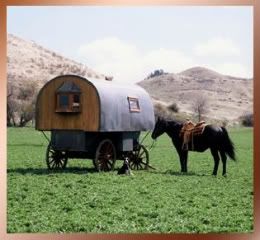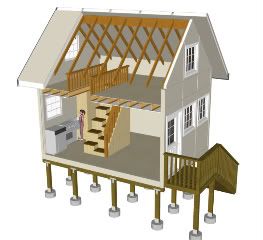 |
Excerpted from Burning the Midnight Oil for Living Energy Independence, in the Burning the Midnight Oil blog-within-a-blog, hosted by kos, though to the best of my knowledge he doesn’t know it. |
 I just recently discussed Tiny Houses as one extreme end of a range of a more sustainable approach to housing. And, because they strike me as really cool, the examples I focused on where the kind of Tiny Houses that can be picked up, put on a trailer, and hauled around, like an old fashioned Shepherd’s Wagon, except with inside plumbing, excellent insulation, and 11 foot ceilings in the main living space.
I just recently discussed Tiny Houses as one extreme end of a range of a more sustainable approach to housing. And, because they strike me as really cool, the examples I focused on where the kind of Tiny Houses that can be picked up, put on a trailer, and hauled around, like an old fashioned Shepherd’s Wagon, except with inside plumbing, excellent insulation, and 11 foot ceilings in the main living space.
Mind you, I always thought that the old-fashioned Shepherd’s Wagon was kind of cool, so add all those “except for’s”, and its no surprise I thought these were cool.
However, just as cool in their own way are the Tiny Houses intended to be built from modular parts on a foundation on site. And as a one-time Mother Earth News reader (back when it was more of a back to the land for dirty stinking hippies magazine), I was interested when the Tiny House Blog mentioned that the post-80’s yuppified “Mother Earth News” has been recently focusing heavily on SIP’s, or Structural Insulated Panels.
Little Green Buildings is a company in Washington (Washington State for those wandering in from the more inside-the-beltway atmosphere of the Big Orange) … from tiny pumphouses, small buildings suitable for a shed or adding a detached office to … well, to proper shacks.
Now, buying the modular SIP panels, you have to provide foundation (concrete or pilings) paint, and of course it does not come furnished … but the price per square foot also comes down compared to the “ready to roll” Tiny Houses.
 |
 |
Take the River Shack … 12×16 (192 sq. ft plus loft), with the complete shell coming in at around $20,000. Add labor, of course … and SIP’s are designed to be put together by people who are not skilled carpenters … paint, a foundation, and its still going to come in at an appealing cost for someone at this extreme end of the spectrum. And, just like the trailer-ready Tiny Houses, a small, well-insulated space is going to cost much less to heat and cool than a larger space will.
Well, OK, so its easier to heat and cool. But that’s not the end of the connections with Sustainable Energy Independence … its only the beginning.
For one thing, when someone reduces the real cost of their housing, by not requiring as much housing, and at the same time reduces their regular utility bills, that leaves more disposable income from the same wage or salary. And that helps that individual overcome the countless traps built into our disposable consumer society — a point that A Siegel has often written about in detail — where the cost to buy a more sustainable option is higher, even though the full cost to own the sustainable option is lower.
When you reduce the footprint of housing costs in your budget — both cost to build and cost to operate — that provides more means to finance other sustainable choices that have higher up-front costs but lower total costs to own. And then down the track, the reduction in operating costs from those choices frees up more room in the budget. A clear example are Pluggable Hybrid Electric vehicles (PHEV), which for the typical car trip in the US will be running on stored electric power … which can be produced sustainably by resources within our borders.
And as the price of gasoline and diesel hits $5/gallon, then $10/gallon, then $20/gallon, the cost-to-own advantage of the PHEV will only get stronger … but unless there is a dramatic price breakthrough in battery or other energy storage technology, it will necessarily have a higher up-front cost to purchase.
Living Within Our Means as a Nation
The core of a Progressive Economic Nationalism is living within our means. Sustainable Energy Independence is only part of that. Material self-sufficiency is another part. Food self-sufficiency is another part.
I have to stress that self-sufficiency does not mean isolationism. It does not mean “no trade, an iron curtain at the border”. Two self-sufficient nations can quite happily trade, to substantial mutual benefit. Indeed, they can trade in more confidence that it is to mutual benefit, because they have the option of not trading if they wish.
So food self-sufficiency does not mean that Buckeyes are “not allowed to eat bananas”. Especially if shipped from the Eastern Caribbean to Miami in sustainably fueled ships, and carried up by high speed electric container freight from Miami, there is nothing “wrong” with swapping Ohio apples for Caribbean bananas.
What self-sufficiency means is the option to say “No” to any given trade. And the option to say “No” is the essence of Economic Independence.
And the greater the energy and material efficiency of providing a comfortable standard of living, the closer we are to arriving at energy and material self-sufficiency.
Creating Livable Local Communities In the Midst of Crisis
There is also another dimension to this that bears thinking about.
Suppose that things start to go to hell in a hand basket.

The most direct action that we can take as individuals is to pitch in to help organize our local communities to cope. And since one of the things likely to happen if things start to go to hell in a hand basket is turmoil and uncertainty in the financial sector, one strong capability for a local community is the ability to supplement liquidity in the national currency with additional liquidity in a local currency.
A local community with the power to tax can create a foundation of demand for a local currency by accepting some portion of a tax assessment that is owed in the local currency. That is, after all, one of the two foundations for the acceptability of the national currency … the ability to meet national tax obligations if you hold the national currency.
How much benefit can a local community hope to gain from this strategy? Well, to work that out, you have to start thinking of the local community as if it was a tiny island nation with its own currency. What limits the ability of that kind of tiny island nation to expand its money supply to meet a liquidity crunch?
Clearly, the limit is how much can be produced with local resources and local labor, and how much has to be imported. And it is easy to see that this is the limit, by considering the two extreme cases.
An island nation that produces its entire national product in products for export, that it did not consume, and consumed its entire national income in imports, has no opportunity whatsoever to provide any effective additional purchasing power by making a local currency available. No matter how much local currency exists, the only question of interest is how much the local currency is worth in terms of the foreign currency used to buy imports.
Now, on the other hand, consider an island nation that produces its entire national product in the products for domestic consumption, with neither imports nor exports. Then if there is a core reason to accept the local currency … like the ability to use it to meet tax obligations … and there are unemployed resources, more resources can be put to use by creating the currency to pay for them.
There is of course a limit to this process. This is, after all, not a magic system for creating products by printing money. The products come from putting the unemployed resources and the unemployed labor to use, and its the value of the products the provides the actual backing for the purchasing power that led groups of people to work together making the stuff.
But that’s OK, because if things are going to hell in a hand basket, so badly that it seriously disrupts the financial system, there will be unemployed resources and unemployed labor, and what will be missing is the incentive to put that combination to work.
Of course, our local community will be closer to the first island nation that sells everything “abroad” to “import” everything … but the more local resources can be put to use in serving local needs, the greater the leeway it has to supplement liquidity in national currency with a local currency. And the greater the material and energy efficiency of the goods produced to meet basic needs … including shelter … the better positioned that community is to ride out the “hell in a hand basket” period.
Come to think of it, the better positioned the more communities are to ride out the storm, the less serious the storm is likely to be.
| Midnight Oil – Hercules (1985) |
… Why wait for the planes to come When everybody’s got us on the run South Pacific carry on Here come the Hercules Here come the submarines Sinking South Pacific dreams |

11 comments
Skip to comment form
Author
First I got critiqued for not having a tip jar, and then the next Midnight Thought I put up a typical “hey, look at me comment” tip jar (well, I’m not sure I filled in all the blanks on the wizard), and got hammered for it, with a toadstool from someone I want ponies from.
So now I’m nervous.
junk I’d never be able to live in such a small space. But I’m working on it, reducing the amount of stuff I have.
Being a technology ‘junkie’ has it’s serious downfalls.
It’s a great concept you have, however.
Well presented, well thought out.
I’ll work harder to break my ‘habit’, I promise!
Packing people into packed cities has the added advantages of total surveillance and total control. It is far easier to control populations in high density housing units than in remote rural areas. The concept of nations is a profanity, an obstacle to the CEO of globo-corp.
Have you seen this one?
http://www.solarroadways.com/I…
I really like the little house concept.